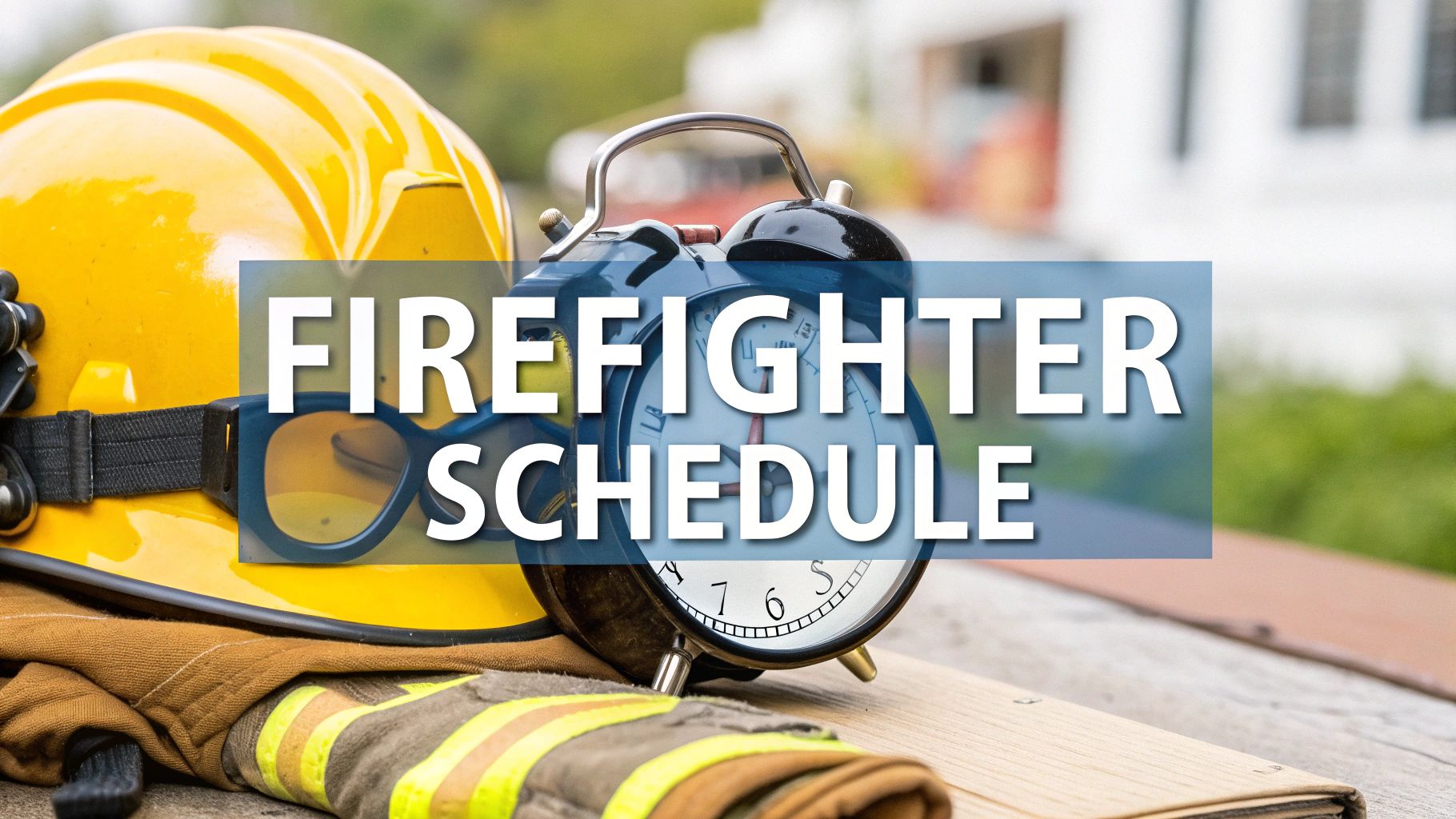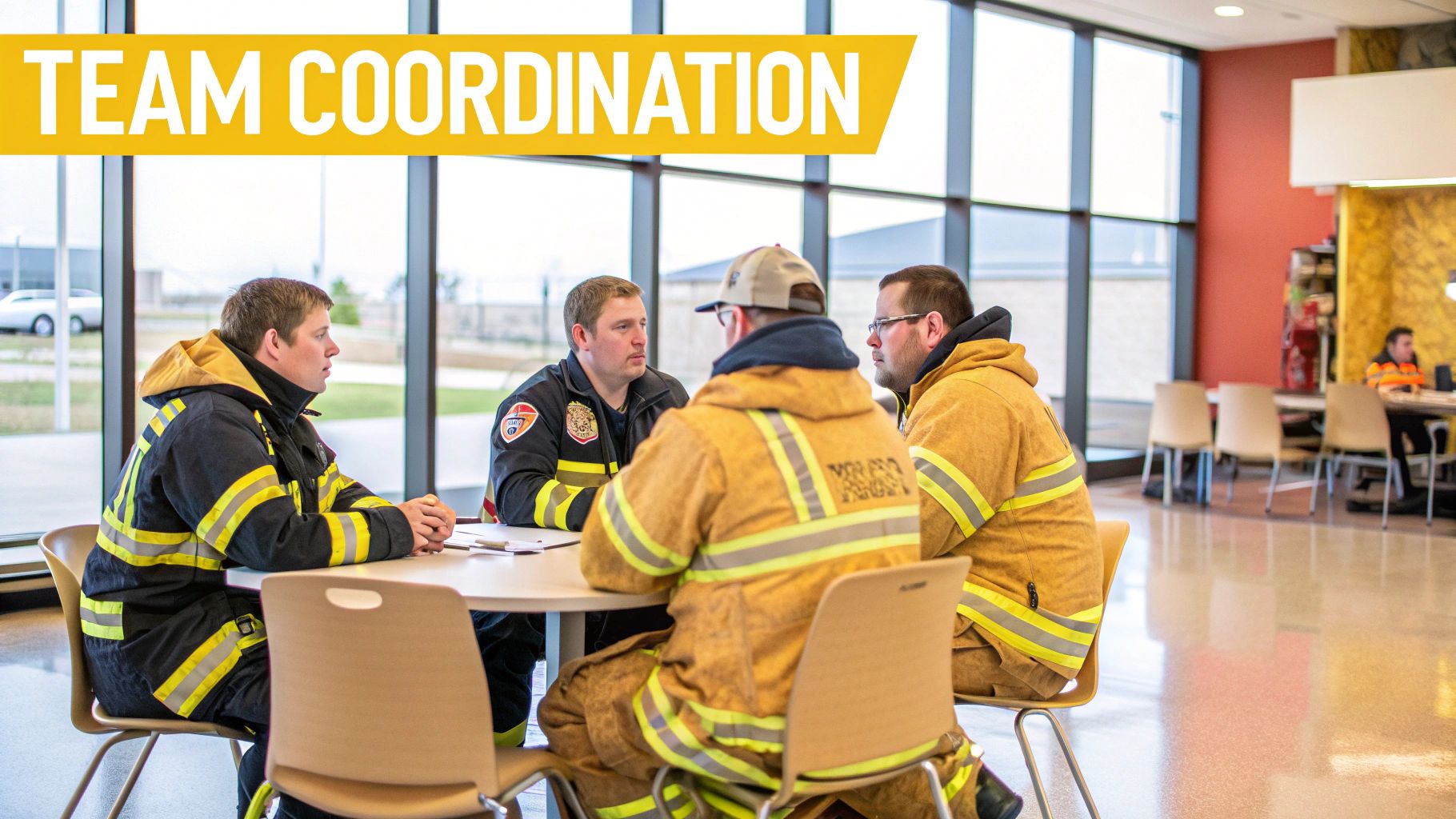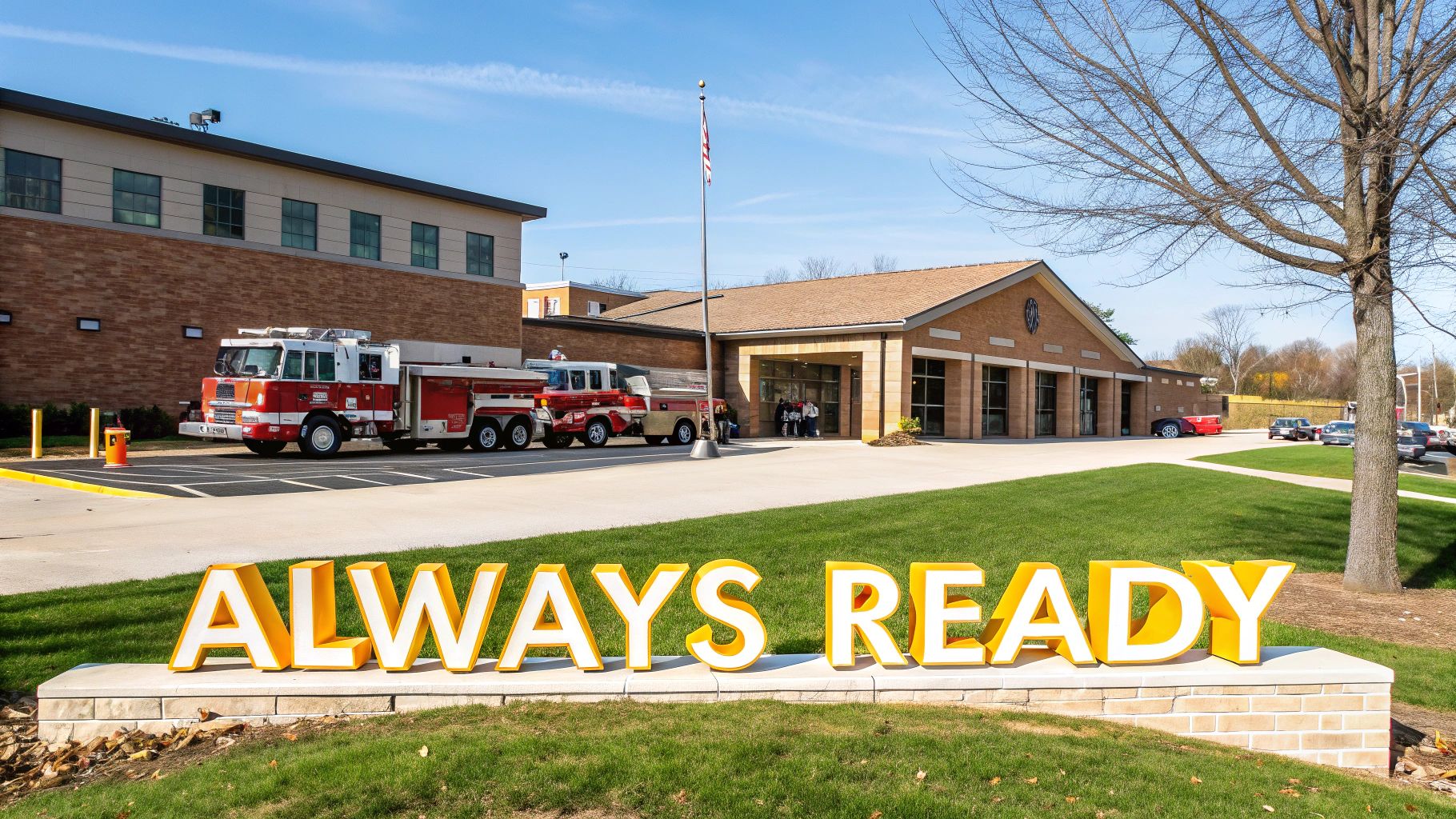From our resource library for organizational scheduling and management.
Inside the Schedule for Firefighters: The Complete Guide to Modern Shift Systems

The Evolution of Firefighter Work Schedules

Fire departments' scheduling has come a long way from the grueling shifts of the past. In the early days, firefighters endured extremely long hours with minimal breaks - a practice that took a heavy toll on both their personal lives and job performance. The physical and mental demands of firefighting made it clear that a better system was needed.
A major breakthrough came in 1936 when Chicago's Mayor Edward J. Kelly worked with the firefighters' union to reduce the workweek to 72 hours. This led to the introduction of the 24-hour shift system, which proved to be a game-changing development. Fire departments adopted the 3-platoon system, where three teams would each work a 24-hour shift followed by two days off.
To stay within labor laws, departments introduced "Kelly days" - extra paid days off that prevent firefighters from exceeding Fair Labor Standards Act (FLSA) overtime limits. This helped create a more sustainable work environment while maintaining round-the-clock emergency coverage. Learn more about the history of firefighter scheduling in this comprehensive research paper.
The Rise of the 24/72 and Other Variations
As departments gained experience with 24-hour shifts, new schedule patterns emerged. The 24/72 schedule became popular, giving firefighters a full 24-hour shift followed by three days (72 hours) off duty. While this offered better rest periods, working for 24 straight hours still presented challenges. Departments had to carefully manage fatigue levels and ensure consistent performance throughout these extended shifts.
Modern Scheduling and the 48/96 Schedule
Many fire departments today are switching to the 48/96 work schedule - two consecutive 24-hour shifts (48 hours) followed by four days (96 hours) off. This approach gives firefighters longer blocks of uninterrupted time away from work, helping them maintain better work-life balance and recover fully between shifts. For more insights on modern workforce scheduling, check out our article about staff roster programs.
Fire departments continue adapting their schedules as they learn more about fatigue management and work-life balance. Their goal remains constant: finding the sweet spot between providing reliable emergency services and taking care of their personnel's wellbeing.
Understanding the 48/96 Schedule in Modern Firefighting
The standard 24-hour shift that defined firefighting schedules for decades is evolving. Fire departments across the country are adopting the 48/96 schedule - a model where firefighters work 48 consecutive hours followed by 96 hours off duty. This approach reflects deeper understanding of rest, recovery, and peak performance in emergency response work. As more departments make this change, it's worth examining how it reshapes firefighting operations.
Benefits of the 48/96 Work Schedule
The extended time off in a 48/96 schedule creates meaningful benefits for firefighters' personal lives. With four full days between shifts, they can maintain stronger family connections, pursue hobbies and education, and properly rest between demanding work periods. The predictable pattern also helps establish better sleep routines, which directly impacts alertness and decision-making during emergency calls.
Fire departments themselves see several operational advantages. The simpler schedule reduces administrative complexity around shift assignments and coverage. Many departments report cost savings from decreased overtime needs. The data shows concrete improvements - for example, departments switching to 48/96 schedules have seen dramatic drops in sick leave usage: 20% at Pacifica Fire, 80% at Manhattan Beach, and 28% at West Metro over six months. See the full analysis here.
Challenges and Considerations
The 48/96 schedule isn't without its hurdles. The 48-hour work period requires careful management of crew fatigue through strategic rest periods and task rotation. Departments must also adapt their training programs and professional development to fit the new rhythm without compromising readiness.
Making the switch demands thorough planning around staffing needs, budget implications, and existing policies. Leadership teams need to examine how the schedule affects everything from overtime rules to vacation requests to emergency coverage. Clear communication with all stakeholders helps identify and address potential issues early.
Implementing the 48/96 Schedule Successfully
A successful transition to 48/96 scheduling starts with strong partnership between management and firefighters. Many departments find that running a pilot program helps work out implementation details before full rollout. Ongoing monitoring lets departments track both benefits and challenges.
Key factors to evaluate include:
- Current staffing levels and minimum coverage requirements
- Call volume patterns across different times and days
- Community needs and demographics
- Impact on training and certification maintenance
- Effects on mutual aid arrangements with nearby departments
Regular check-ins and willingness to make adjustments help ensure the schedule serves both the department and its firefighters effectively. With proper planning and execution, the 48/96 model can support both operational excellence and firefighter wellbeing.
Real-World Implementation Success Stories

When fire departments change their schedules, the process involves much more than adjusting time slots. Success requires thoughtful planning and direct communication with everyone involved. Looking at how other departments handled similar changes provides practical insights that can help smooth the transition.
The Orange County Fire Authority: A Case Study in 48/96 Implementation
The Orange County Fire Authority (OCFA) shows both the opportunities and challenges of switching to a 48/96 schedule. They started testing the schedule in 2015 and made it permanent in 2016 after firefighters voted to approve it. But by 2018, some issues emerged - firefighters were picking up 3.6 extra shifts per month on average to cover staffing gaps. This detailed analysis from Firehouse Magazine explores how staffing levels directly impact schedule effectiveness.
Addressing Staffing Challenges
The OCFA's experience shows why departments need to plan carefully for staff coverage. Before changing schedules, departments should look at their current staff numbers and think about future needs. This includes considering upcoming retirements, expected increases in emergency calls, and how the new schedule might affect staff availability.
- Recruitment and Retention: Building strong programs to hire and keep qualified firefighters becomes especially important with schedules like the 48/96.
- Flexible Staffing Models: Having part-time or reserve firefighters available can help fill gaps during busy times or when regular staff are off duty.
- Data-Driven Decisions: Regular review of call volumes, response times, and staff levels helps identify patterns and guides schedule adjustments.
Building Buy-In and Managing Change
Departments that successfully implement new schedules make sure to involve everyone in the process. This means talking with firefighters, union representatives, and administrative staff from the start of planning through implementation. When people feel heard and included, they're more likely to support the changes.
Measuring Success and Continuous Improvement
Changing schedules is an ongoing process that requires regular monitoring. Departments should track specific measures including:
- Overtime costs
- Sick leave usage
- Firefighter morale and job satisfaction
- Response times
By watching these numbers closely, departments can spot problems early and make needed adjustments. This approach helps ensure the schedule continues to work well as department needs change over time.
Maximizing Work-Life Balance and Firefighter Well-being

The way firefighters structure their work hours shapes every aspect of their lives. Having meaningful time away from the job is essential - not just for rest, but for building strong relationships and maintaining mental health. When departments get scheduling right, it leads to better performance on the job and happier, healthier firefighters who stay in the profession longer.
The Importance of Fatigue Management and Sleep Optimization
Working long shifts like the 48/96 schedule takes a real toll on the body's natural sleep patterns. Good sleep isn't just about getting enough hours - it's about finding ways to rest well even when working overnight or extended shifts. Smart departments help their teams by teaching sleep strategies, allowing strategic rest periods during shifts, and creating schedules that work with, not against, our natural daily rhythms.
Supporting Mental and Physical Wellness
The physical demands and emotional stress of firefighting affect people deeply. Forward-thinking departments now focus on supporting their firefighters' overall health. This means offering counseling services, running fitness programs, and encouraging healthy habits both on and off duty. When departments invest in their people this way, teams become stronger and more capable of handling tough situations. You might be interested in: How to master shift scheduling with apps.
Balancing Operational Readiness and Family Life
Family life often feels the strain when firefighters work unusual hours. The 48/96 schedule has gained popularity because it offers clear blocks of time at home, letting firefighters truly be present for family dinners, school events, and special occasions. This predictability helps build stronger family bonds and reduces the stress that shift work places on relationships.
Measuring and Improving Quality of Life
To know if a schedule really works, departments need concrete data. By tracking things like sick days, overtime usage, and regular feedback from crews, leaders can see the real impact of their scheduling choices. The most successful departments regularly check in with their teams and adjust their approach based on what they learn. This ongoing process helps create better working conditions while maintaining excellent emergency response.
Strategic Staffing and Resource Optimization
Managing a fire department's resources effectively is essential for maintaining public safety while working within real-world constraints. Getting staffing right directly impacts both service quality and department sustainability. Smart staffing isn't just about filling shifts - it requires using data and proven systems to make the best possible decisions.
Balancing Personnel Needs and Budget Constraints
Fire departments face the constant challenge of maintaining adequate staffing levels without breaking the budget. When departments are short-staffed, overtime costs add up quickly and firefighters risk burning out. A recent study of the Orange County Fire Authority found firefighters working an average of 3.6 overtime shifts per month just to cover basic staffing needs. This shows why careful planning and efficient scheduling systems are so important.
Managing Overtime and Vacation Scheduling
The right scheduling tools make a huge difference in controlling overtime costs and coordinating time off requests. Good software helps departments spot potential coverage gaps early, so they can plan ahead rather than scrambling to fill last-minute openings. These systems also help distribute vacation time fairly while keeping enough staff on duty. For more scheduling tips, check out our guide on how to master employee scheduling with a free template.
Maintaining Consistent Coverage Across Shifts
Reliable emergency services require consistent staffing levels around the clock. By analyzing call data, departments can identify their busiest periods and staff accordingly. This prevents both understaffing during peak times and unnecessary overtime during slower periods.
Data-Driven Approaches to Staffing Optimization
Looking at the numbers helps departments work smarter, not just harder. Tracking key metrics like response times, call volumes, and staff availability reveals clear patterns. Departments can use these insights to fine-tune their scheduling and make sure they have the right people in the right places at the right times.
Tools and Frameworks for Immediate Implementation
Fire departments have access to practical tools that can improve their scheduling right away. Modern scheduling software handles everything from shift assignments to overtime tracking to vacation management automatically. Standard templates and guidelines help keep scheduling consistent and fair across the department. These tools reduce administrative headaches while helping create a more effective workforce.
Regular training is also crucial for keeping firefighters' skills sharp as their job continues to evolve. This includes staying current with new technology, emergency procedures, and best practices for staying physically and mentally fit. When departments invest in their firefighters' growth, everyone benefits - the individual firefighters, the department as a whole, and most importantly, the community they serve.
Future Trends and Strategic Recommendations

The way fire departments operate continues to shift as new challenges emerge. Success depends on smart scheduling that balances the needs of firefighters with community demands. Taking a proactive approach to these changes helps build stronger departments ready to serve their communities effectively.
Technology's Impact on Scheduling
Modern scheduling software has become essential for running efficient fire departments. These tools handle everything from basic shift assignments to complex overtime calculations, giving chiefs and administrators more time to focus on strategic decisions. With access to real-time data about emergency calls and response times, departments can now place the right number of firefighters exactly where they're needed. This data-driven approach leads to better coverage and faster response times.
Addressing the Changing Workforce
Today's firefighters have different expectations about work-life balance than previous generations. Many departments now offer adapted schedules like compressed workweeks to help crews manage family time and personal commitments. This flexibility has become key for both recruiting new talent and keeping experienced firefighters on the job. As departments grow more diverse, scheduling must account for varied needs while maintaining consistent emergency coverage.
Meeting Evolving Community Needs
Communities change over time, and fire departments must change with them. Regular analysis of emergency call patterns reveals when and where services are needed most. For example, neighborhoods with growing elderly populations often see more medical calls, requiring departments to adjust their staffing accordingly. Understanding these patterns helps ensure the right resources are available at the right times.
Strategic Recommendations for the Future
Making smart changes now prepares departments for future success. Here are key steps fire departments should consider:
- Invest in Technology: Choose scheduling software that makes daily operations easier while providing useful data about department performance
- Prioritize Firefighter Well-being: Create schedules that help prevent burnout and support healthy work-life balance. The Federal Wildland Firefighter Health and Wellbeing Program offers a good model for this approach. Alabama's new requirements for training on working with people who have sensory needs or invisible disabilities shows how departments are adapting to serve everyone better.
- Engage with the Community: Stay connected with local residents to understand how their needs are changing
- Use Data Effectively: Track important numbers like response times and call volumes to spot trends and make better decisions
- Build Strong Teams: Keep open lines of communication between leadership, firefighters, and unions when making schedule changes
Make your department's scheduling simpler and more effective with Acroroster. Our platform helps you manage complex schedules while taking good care of your firefighters. Visit Acroroster to see how we can help your department.